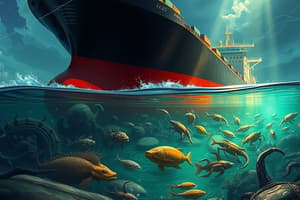Podcast
Questions and Answers
Which type of treatment is used to eliminate organisms from ballast water?
Which type of treatment is used to eliminate organisms from ballast water?
- Chemical treatment (correct)
- Physical treatment
- Biological treatment
- All of the above
What is the purpose of ballast water treatment?
What is the purpose of ballast water treatment?
- To improve the taste of drinking water on board
- To reduce fuel consumption
- To prevent the spread of invasive species (correct)
- To increase the weight of the ship
What is the consequence of not treating ballast water?
What is the consequence of not treating ballast water?
- Decreased fuel consumption
- Improved water quality
- Introduction of invasive species (correct)
- Reduced risk of collisions
Which of the following is a characteristic of plankton?
Which of the following is a characteristic of plankton?
Which of the following is an example of nekton?
Which of the following is an example of nekton?
What is the difference between epifauna and infauna?
What is the difference between epifauna and infauna?
Flashcards are hidden until you start studying
Study Notes
Ballast Water Treatment
- Physical, chemical, or biological treatments are used to eliminate organisms from ballast water to prevent the introduction of invasive species.
Purpose of Ballast Water Treatment
- The purpose of ballast water treatment is to prevent the introduction of invasive species, which can cause harm to the environment, economy, and human health.
Consequences of Not Treating Ballast Water
- If ballast water is not treated, it can lead to the introduction of invasive species, which can cause significant ecological, economic, and social impacts.
Characteristics of Plankton
- Plankton are tiny, usually microscopic, organisms that drift in the water column, and are an essential component of aquatic food webs.
Examples of Nekton
- Nekton are actively swimming organisms, and examples include fish, squid, and dolphins.
Difference between Epifauna and Infauna
- Epifauna are organisms that live on the surface of the sediment, whereas infauna are organisms that live within the sediment.
Studying That Suits You
Use AI to generate personalized quizzes and flashcards to suit your learning preferences.




